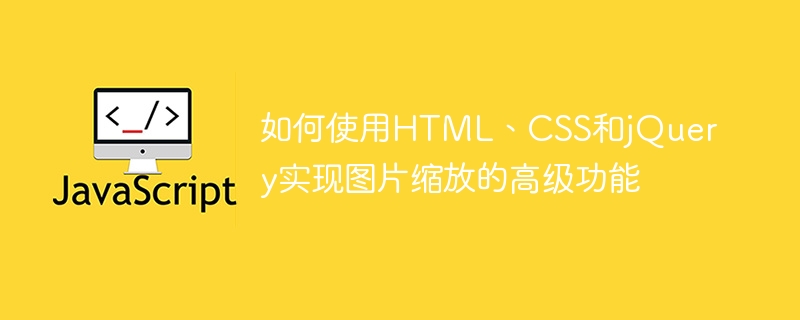Home >Web Front-end >JS Tutorial >How to use HTML, CSS and jQuery to implement advanced image zoom functions

How to use HTML, CSS and jQuery to implement the advanced function of image scaling
Introduction:
In modern web design, the beauty and adaptability of images are very important . However, conventional picture display often cannot meet our needs. In this article, we will introduce how to use HTML, CSS and jQuery to implement some advanced image zoom functions. Through these technologies, we can achieve customized image scaling effects and add more interactivity to our web pages.
Step 1: HTML markup
First, we need a basic HTML structure to display images and some controls. Here is a simple example:
<div class="image-container">
<img src="image.jpg" alt="Image">
<div class="controls">
<button class="zoom-in">放大</button>
<button class="zoom-out">缩小</button>
<button class="reset">重置</button>
</div>
</div>In this example, we use a <div> element to contain the image and controls. The URL of the image is specified through the <code>src attribute, and the controls include zoom in, zoom out and reset buttons.
Step 2: CSS Styles
Next, we need some CSS styles to control how the image is rendered. The following is a basic style example:
.image-container {
position: relative;
width: 500px;
height: 500px;
overflow: hidden;
}
img {
max-width: 100%;
max-height: 100%;
}
.controls {
position: absolute;
bottom: 10px;
left: 50%;
transform: translateX(-50%);
}
button {
margin: 0 5px;
}In this style, .image-container defines the container of the image, and sets the width, height and overflow style to control the display area of the image . The style of the img tag sets the maximum width and maximum height to ensure that the image is displayed correctly within the container. .controls defines the style of the control and uses position: absolute to position it at the bottom of the image container.
Step 3: jQuery code
Now, we can use jQuery to implement the zoom function of the image. Here is a simple code example:
$(document).ready(function() {
var image = $(".image-container img");
var zoomLevel = 1;
$(".zoom-in").click(function() {
zoomLevel += 0.1;
image.css("transform", "scale(" + zoomLevel + ")");
});
$(".zoom-out").click(function() {
zoomLevel -= 0.1;
image.css("transform", "scale(" + zoomLevel + ")");
});
$(".reset").click(function() {
zoomLevel = 1;
image.css("transform", "scale(" + zoomLevel + ")");
});
});In this code, we first use $(document).ready() to ensure that the code is executed after the page is loaded. Then, we get the jQuery objects of the picture element and control button.
When the "zoom-in" button is clicked, we increase the zoom level by 0.1 and use the css() method to set the transform style of the image element to achieve zooming. Effect.
When the "zoom-out" button is clicked, we reduce the zoom level by 0.1, and also use the css() method to set the transform style of the image element to achieve Zoom out effect.
When the "reset" button is clicked, we reset the zoom level to 1 and also use the css() method to set the transform style of the image element so that The picture is restored to its original size.
Summary:
Through the combination of HTML, CSS and jQuery, we can implement customized advanced image scaling functions. We can adjust the zoom level as needed and add more interactive controls to improve the user experience. I hope the sample code in this article can help you achieve more interesting image display effects.
The above is the detailed content of How to use HTML, CSS and jQuery to implement advanced image zoom functions. For more information, please follow other related articles on the PHP Chinese website!